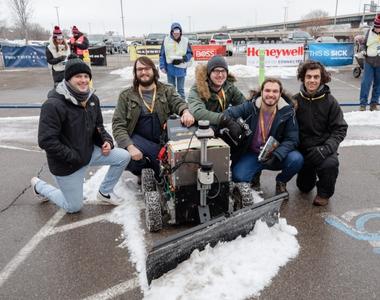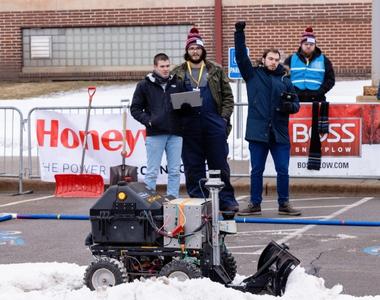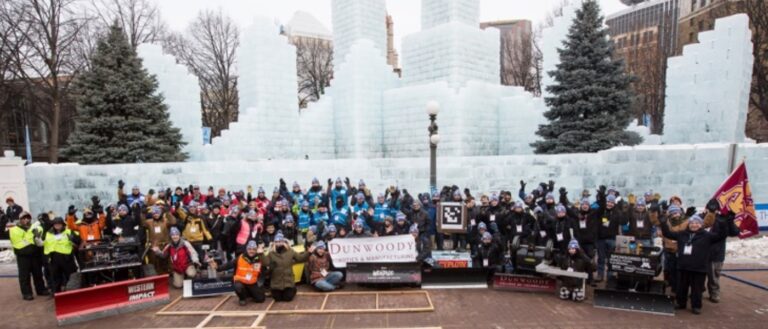
A group of mechanical and aerospace engineering students took home first place at the 13th Annual Autonomous Snowplow Competition held Jan. 20-21, 2023, at Dunwoody College in Minneapolis, Minnesota. The winners were Ian Adams, Shane Riddle, Clayton Jackson, Nathan Mengers and Austin Mills.
The autonomous snowplow competition (ASC) is a competition run by the Institute of Navigation, with the aim of challenging students in the areas of robotic navigation and guidance. Student teams had to construct robot snowplows with the task of clearing an artificial test course. Teams scored points prior to the actual competition through preliminary design presentations and a team poster. At the actual competition, teams took turns in a best of two format and attempted to plow the competition field autonomously, avoiding obstacles, remaining in bounds, and returning to a designated garage area once complete. Teams are scored based on the number of obstacles hit, amount of snow cleared, and ability to return to the designated area.
CWRU’s team this year was a number of PhD students from the biorobots group. Their robot, Otto, is a robot platform with a long history stretching back in some form or the other to Dexter and the DARPA urban challenge.
The students tend to use the competition as an opportunity to practice practical robotics, and to develop skills for all facets of robotics. Typically, students have a niche specialty in coding, manufacturing, or design, for instance. But as a team, they feel it’s very important to all be involved in all aspects. The CWRU students arrived a day or two before the competition, to give themselves ample time to correct any problems their robot might have had. After a few mechanical tunings, they were together as expected, collaboratively coding on the TV of their Airbnb.

Their team had the misfortune of randomly being assigned the first slot in the competition’s morning trial. Naturally this meant that they would be pulling a near all-nighter to test their robot into the ground. After a few middling practice runs, just before 9 p.m. they encountered an issue which would plague their runs for the next day: a bad circuit breaker. The robot expects to pull a large amount of current when operating, and even more under a heavy snow load. In this case, their circuit breaker was determined to be both the incorrect type, and also actively breaking down. This meant that the robot couldn’t perform even moderately difficult motion without tripping the hair trigger circuit breaker. They devised a way to prevent it from triggering, and turned in for a brief two-hour nap, before having to get ready for their run. The first run went as expected. The robot maneuvered into some snow, before repeatedly tripping the breaker and needing full restarts. Their score for the first attempt was only good enough for second to last place.
They scoured auto parts stores to dig up a suitable replacement for the circuit breaker, and rapidly set about replacing it. An advantage of having failed first was that they had more time to recover before the afternoon attempt. A part swap later, and they resumed testing. Soon enough a new problem arose: their navigation system worked sporadically. In certain conditions it performed fine, but in others it would seize and do absolutely nothing. In a rush, they decide to rewrite it, opting for a new take on older code from last year, rather than trying to polish the scratches out of our current code. They had just enough time to attempt a practice run before they were needed back for their last attempt. Their last test run wasn’t great but their time was up. Shane and Clayton manually edited some of the waypoints during the walk-up to the field, but now they had to run for real. No way to test their fixes first.
And so, they pushed start. And the robot worked better than they had ever hoped. The only points where they were concerned were the turns around the obstacle, which thanks to the last minute tweaks, worked perfectly. The robot neither hit obstacles nor left the competition field, and ultimately returned to the garage zone for a pretty perfect run, much to the shock of the judges and themselves.
Awards prior to this year for the autonomous snowplow competition are as follows:
1. 1st place in collaborative event, Annual ION Autonomous Snowplow Competition, St. Paul, MN, January 2022.
2. 1st place, Annual ION Autonomous Snowplow Competition, virtual, 2021.
3. 1st place, Annual ION Autonomous Snowplow Competition, St. Paul, MN, Jan. 2020.
4. 1st place and 2nd place, Annual ION Autonomous Snowplow Competition, Toronto, Canada, Jan. 2019.
5. 1st place, Annual ION Autonomous Snowplow Competition, St. Paul, MN, Jan. 2017
6. 2nd place, Annual ION Autonomous Snowplow Competition, St. Paul, MN, Jan. 2016
For the autonomous lawnmower competition, which ended in 2012:
1. 3rd place, 9th Annual ION Autonomous Lawnmower Competition, Dayton, Ohio, May 2012
2. 1st place, 8th Annual ION Autonomous Lawnmower Competition, Dayton, Ohio, June 2011
3. 1st place, 7th Annual ION Autonomous Lawnmower Competition, Dayton, Ohio, June 2010
4. 1st place, 6th Annual ION Autonomous Lawnmower Competition, Dayton, Ohio, May 28-30, 2009
5. 3rd place, 5th Annual ION Autonomous Lawnmower Competition, Dayton, Ohio, June 5-7, 2008


